Раздел: Климат
Тип: Водонагреватель Накопительный
Характеристики, спецификации
Тип водонагревателя:
накопительный
Способ нагрева:
электрический
Нагревательный элемент:
трубчатый
Способ подачи воды:
напорный
Максимальная температура нагрева воды:
+80 °С
Давление на входе:
0.20 — 7 атм.
Номинальная мощность:
1.5 кВт
Функции:
индикатор включения, термометр
Защита:
ограничение температуры нагрева,магниевый анод, защита от перегрева, предохранительный клапан
Установка:
вертикальная, нижняя подводка, способ крепления: настенный
Размеры (ШхВхГ):
450x758x470 мм
Инструкция к Водонагревателю Накопительному Ariston ABS PRO ECO 80V

100
95
75
25
5
0

100
95
75
Óñòàíîâêà âîäîíàãðåâàòåëÿ
Óñòàíîâêà è ïåðâûé çàïóñê âîäîíàãðåâàòåëÿ äîëæíû îñóùåñòâëÿòüñÿ
êâàëèôèöèðîâàííûì ñïåöèàëèñòîì, êîòîðûé ìîæåò íåñòè îòâåòñòâåííîñòü çà
25
ïðàâèëüíîñòü óñòàíîâêè è äàòü ðåêîìåíäàöèè ïî èñïîëüçîâàíèþ âîäîíàãðåâàòåëÿ
Ïðè ïîäêëþ÷åíèè äîëæíû áûòü ñîáëþäåíû äåéñòâóþùèå ñòàíäàðòû è ïðàâèëà
5
Íåäîïóñòèìà óñòàíîâêà âåðòèêàëüíûõ ìîäåëåé (V) ãîðèçîíòàëüíî, à ãîðèçîíòàëüíûõ
ìîäåëåé (Í) — âåðòèêàëüíî.
0

Äëÿ ñîêðàùåíèÿ ïîòåðü òåïëà ÷åðåç òðóáîïðîâîä ïðèáîð ñëåäóåò óñòàíîâèòü íà
ìèíèìàëüíîì ðàññòîÿíèè îò âîäîðàçáîðíîãî óçëà (À ðèñ. 1 è ðèñ. I). Äëÿ ïðîâåäåíèÿ
òåõíè÷åñêîãî îáñëóæèâàíèÿ îáåñïå÷üòå âîêðóã ïðèáîðà ñâîáîäíîå ïðîñòðàíñòâî íå ìåíåå
50 ñì, à îò ïîòîëêà — íå ìåíåå 10 ñì (ðèñ. II). Äëÿ êðåïëåíèÿ ïðèáîðà ðåêîìåíäóåòñÿ
èñïîëüçîâàòü êðþêè ñ äèàìåòðîì íå ìåíåå 12 ìì (ðèñ. III). Â çàâèñèìîñòè îò âûáðàííîé âàìè
ìîäåëè âîäîíàãðåâàòåëÿ, âàì ïîíàäîáÿòñÿ 2 èëè 4 òàêèõ êðþêà. Ïîäãîòîâëåííîå êðåïëåíèå
äîëæíî âûäåðæèâàòü òðîåêðàòíûé âåñ íàïîëíåííîãî âîäîé âîäîíàãðåâàòåëÿ.
Ïîäñîåäèíÿéòå ïàòðóáêè âîäîíàãðåâàòåëÿ òîëüêî ê òðóáàì è ôèòèíãàì, ðàññ÷èòàííûì
íà òåìïåðàòóðó, ïðåâûøàþùóþ 80 °Ñ ïðè ìàêñèìàëüíîì ðàáî÷åì äàâëåíèè. Íå ðåêîìåí-
äóåòñÿ èñïîëüçîâàòü ìàòåðèàëû, íå ðàññ÷èòàííûå íà âûñîêèå òåìïåðàòóðû. Óñòàíîâèòå
ïðåäîõðàíèòåëüíûé êëàïàí (ðèñ. IV) íà âõîäå õîëîäíîé âîäû âîäîíàãðåâàòåëÿ (òðóáêà
âõîäà ïîìå÷åíà ñèíèì êîëüöîì). Ïðåäîõðàíèòåëüíûé êëàïàí ñðàáàòûâàåò ïðè äàâëåíèè
âîäû 0,7 ÌÏà (7 áàð).
â âîäîíàãðåâàòåëå ñâûøå
ÂÍÈÌÀÍÈÅ! Óñòàíîâêà ïðåäîõðàíèòåëüíîãî êëàïàíà, âõîäÿùåãî â êîìïëåêò,
ÿâëÿåòñÿ îáÿçàòåëüíûì òðåáîâàíèåì.
Äëÿ îáëåã÷åíèÿ îáñëóæèâàíèÿ âîäîíàãðåâàòåëÿ ðåêîìåíäóåòñÿ óñòàíîâèòü ñëèâíîé
âåíòèëü-òðîéíèê (ðèñ. IV) ìåæäó âõîäîì âîäîíàãðåâàòåëÿ è ïðåäîõðàíèòåëüíûì êëàïàíîì.
Äàííûé òðîéíèê ïîìîæåò ñëèâàòü âîäó èç âîäîíàãðåâàòåëÿ, íå âûêðó÷èâàÿ
ïðåäîõðàíèòåëüíûé êëàïàí. Äëÿ óäîáñòâà ðåêîìåíäóåòñÿ ïîäñîåäèíèòü ê âåíòèëþ òðîéíèêà
øëàíã äëÿ ñëèâà âîäû. Ýòîò øëàíã ïîçâîëèò íàïðàâëÿòü ñëèâàåìóþ èç âîäîíàãðåâàòåëÿ
âîäó â êàíàëèçàöèþ èëè äðóãîå âûáðàííîå Âàìè ìåñòî.
Ïðèñîåäèíèòå âõîäíîé ïàòðóáîê ïðåäîõðàíèòåëüíîãî êëàïàíà ê ìàãèñòðàëè õîëîäíîé
âîäû ñ ïîìîùüþ ãèáêîãî øëàíãà. Ïðè íåîáõîäèìîñòè óñòàíîâèòå çàïîðíûé âåíòèëü.
Ïðè çàòÿãèâàíèè ñîåäèíåíèé íå ïðèêëàäûâàéòå ÷ðåçìåðíûõ óñèëèé. Îñîáåííî äëÿ
ïðåäîõðàíèòåëüíîãî êëàïàíà. Ïðåäîõðàíèòåëüíûé êëàïàí ðåêîìåíäóåòñÿ çàâîðà÷èâàòü íå
áîëåå ÷åì íà 3-4 îáîðîòà, îáåñïå÷èâ ãåðìåòè÷íîñòü ëåíòîé ôóì.  ðåæèìå íàãðåâà èç
äðåíàæíîãî îòâåðñòèÿ ïðåäîõðàíèòåëüíîãî êëàïàíà ìîæåò êàïàòü âîäà. Äëÿ îòâîäà ýòîé
âîäû ïðèìåíÿåòñÿ äðåíàæíûé øëàíã, êîòîðûé äîëæåí áûòü ïðîëîæåí ñ óêëîíîì âíèç.
0
Òåìïåðàòóðà â çîíå ïðîêëàäêè äðåíàæíîãî øëàíãà íå äîëæíà îïóñêàòüñÿ íèæå 0 Ñ. Åñëè
äàâëåíèå âîäû â âîäîïðîâîäå áëèçêî ê äàâëåíèþ ñðàáàòûâàíèÿ ïðåäîõðàíèòåëüíîãî
êëàïàíà, òî ïåðåä ïðåäîõðàíèòåëüíûì êëàïàíîì ñëåäóåò óñòàíîâèòü ïîíèæàþùèé
ðåäóêòîð. Âî èçáåæàíèå çàñîðåíèÿ âîäîðàçáîðíîé àðìàòóðû èëè äóøåâîé íàñàäêè èç òðóá
äîëæíû áûòü óäàëåíû ïîñòîðîííèå ÷àñòèöû è ãðÿçü. Äëÿ óâåëè÷åíèÿ ñðîêà ñëóæáû
ïðèáîðà ïðèìåíÿåòñÿ ýëåêòðîõèìè÷åñêàÿ çàùèòà îò êîððîçèè (ìàãíèåâûé àíîä). Îäíàêî
0
ýòà çàùèòà íå ìîæåò èñïîëüçîâàòüñÿ ïðè æåñòêîñòè âîäû íèæå 12 F. Ñ äðóãîé ñòîðîíû,
ýêñïëóàòàöèÿ âîäîíàãðåâàòåëÿ ñ âîäîé âûñîêîé æåñòêîñòè ïðèâîäèò ê îáðàçîâàíèþ
èçâåñòêîâûõ îòëîæåíèé, êîòîðûå ñíèæàþò ïðîèçâîäèòåëüíîñòü ïðèáîðà è ìîãóò ïðèâåñòè ê
âûõîäó èç ñòðîÿ íàãðåâàòåëüíîãî ýëåìåíòà.
Ýëåêòðè÷åñêîå ïîäêëþ÷åíèå
Ïåðåä íà÷àëîì ëþáûõ ðàáîò óáåäèòüñÿ, ÷òî âîäîíàãðåâàòåëü ïîëíîñòüþ
îòêëþ÷åí îò ýëåêòðè÷åñêîé ñåòè
100
Ýëåêòðîìîíòàæ ïðèáîðà äîëæåí âûïîëíÿòü êâàëèôèöèðîâàííûé ñïåöèàëèñò ñ
ñîáëþäåíèåì ïðàâèë òåõíèêè áåçîïàñíîñòè. Ôèðìà-èçãîòîâèòåëü íå íåñåò îòâåòñòâåííîñòè
95
çà ïîâðåæäåíèÿ ïðèáîðà âñëåäñòâèå íåïðàâèëüíîãî çàçåìëåíèÿ èëè íåïðàâèëüíûõ
ïàðàìåòðîâ èñòî÷íèêà ýëåêòðîïèòàíèÿ.
75
Ïàðàìåòðû èñòî÷íèêà ýëåêòðîïèòàíèÿ äîëæíû ñîîòâåòñòâîâàòü òåõíè÷åñêèì õàðàêòå-
ðèñòèêàì âîäîíàãðåâàòåëÿ, óêàçàííûì íà çàâîäñêîé òàáëè÷êå. Ïðèìåíÿéòå êàáåëü ñ
ñîîòâåòñòâóþùèì ñå÷åíèåì æèë.
Ïðèìåíåíèå òðîéíèêîâ, óäëèíèòåëåé è ïåðåõîäíèêîâ íå äîïóñêàåòñÿ. Íå ïîäñîåäèíÿéòå
êàáåëü çàçåìëåíèÿ ïðèáîðà ê âîäîïðîâîäíûì è ãàçîâûì òðóáàì. Åñëè âîäîíàãðåâàòåëü
25
ïîñòàâëÿåòñÿ ñ êàáåëåì ýëåêòðîïèòàíèÿ, êîòîðûé â áóäóùåì ïîíàäîáèòüñÿ ïîìåíÿòü,
2
èñïîëüçóéòå êàáåëü ñîîòâåòñòâóþùåãî òèïà (H05VV-F 3õ1,5 ìì , Ø 8,5 ìì). Ïðîäåíüòå
5
êàáåëü ýëåêòðîïèòàíèÿ â ñîîòâåòñòâóþùåå îòâåðñòèå â çàäíåé ïàíåëè ïðèáîðà è
ïðèñîåäèíèòå ê êëåììîé êîëîäêè (M, ðèñ 3-4-5-6). Çàòåì êàæäûé èç ïðîâîäêîâ äîëæíû áûòü
0

çàôèêñèðîâàíû â êîëîäêå ñîîòâåòñòâóþùèìè áîëòèêàìè. Äëÿ îòêëþ÷åíèÿ âíåøíåãî
ýëåêòðîïèòàíèÿ ïðèáîðà ïîëüçóéòåñü 2-ïîëþñíûì âûêëþ÷àòåëåì, ñîîòâåòñòâóþùèì
ñòàíäàðòó CEI-EN ñ èçîëÿöèîííûì ðàññòîÿíèåì ìåæäó êîíòàêòàìè íå ìåíåå 3 ìì. Â öåïè
ýëåêòðîïèòàíèÿ ðåêîìåíäóåòñÿ óñòàíîâèòü ïðåäîõðàíèòåëè.
Âîäîíàãðåâàòåëü äîëæåí áûòü çàçåìëåí. Ïðîâîä çàçåìëåíèÿ (æåëòî-çåëåíîãî öâåòà,
äëèííåå ôàçíûõ ïðîâîäîâ) ñëåäóåò ïîäñîåäèíèòü ê êëåììå, îáîçíà÷åííîé ñèìâîëîì (G,
Ðèñ 3-4-5-6). Çàêðåïèòå êàáåëü ýëåêòðîïèòàíèÿ ñ ïîìîùüþ êàáåëüíûõ çàæèìîâ. Óáåäèòåñü,
÷òî ïàðàìåòðû èñòî÷íèêà ýëåêòðîïèòàíèÿ ñîîòâåòñòâóåò òåõíè÷åñêèì õàðàêòåðèñòèêàì
ïðèáîðà. Åñëè âîäîíàãðåâàòåëü íå óêîìïëåêòîâàí êàáåëåì ýëåêòðîïèòàíèÿ, òî
ïîäêëþ÷åíèå ìîæåò áûòü âûïîëíåíî ñëåäóþùèìè ñïîñîáàìè:
— ïîñòîÿííîå ïîäêëþ÷åíèå ñ ïîìîùüþ êàáåëÿ, ïðîëîæåííîãî â æåñòêîé òðóáå, åñëè ïðèáîð
íå îáîðóäîâàí êàáåëüíûìè çàæèìàìè;
2
— ïîäêëþ÷åíèå ñ ïîìîùüþ ãèáêîãî êàáåëÿ (òèï H05VV-F 3õ1,5 ìì , Ø 8,5 ìì), åñëè ïðèáîð
îáîðóäîâàí êàáåëüíûìè çàæèìàìè.
Ñõåìà ýëåêòðè÷åñêîãî ïîäêëþ÷åíèÿ ïðåäñòàâëåíà íà ðèñ. 3-4-5-6.
Ââîä â ýêñïëóàòàöèþ
Ïåðåä ïîäêëþ÷åíèåì âîäîíàãðåâàòåëÿ ê èñòî÷íèêó ýëåêòðîïèòàíèÿ îáÿçàòåëüíî çàïîë-
íèòå áàê âîäîé. Äëÿ ýòîãî îòêðîéòå âåíòèëü ïîäà÷è âîäîïðîâîäíîé âîäû â âîäîíàãðåâàòåëü è
êðàí ãîðÿ÷åé âîäû íà ñìåñèòåëå. Êàê òîëüêî âîäîíàãðåâàòåëü íàïîëíèòñÿ, èç êðàíà ïîòå÷åò
âîäà. Ïðîâåðüòå ôëàíåö íà íàëè÷èå ïðîòå÷åê è, ïðè íåîáõîäèìîñòè, ïîäòÿíèòå áîëòû
ôëàíöà. Ïîäàéòå ýëåêòðîïèòàíèå, âêëþ÷èâ âûêëþ÷àòåëü.
Ñëèâ âîäû
— îòêëþ÷èòå ýëåêòðîïèòàíèå ïðèáîðà;
— çàêðîéòå âåíòèëü ïîäà÷è õîëîäíîé âîäû â âîäîíàãðåâàòåëü;
— îòêðîéòå êðàí ãîðÿ÷åé âîäû íà ñìåñòèåëå (â ðàêîâèíå èëè âàííîé);
— îòêðîéòå ñëèâíîé êðàí òðîéíèêà (Â ðèñ.2 è ðèñ.IV).
Çàìåíà âíóòðåííèõ ýëåìåíòîâ
Âíèìàíèå! Îòêëþ÷èòå âîäîíàãðåâàòåëü îò ïèòàíèÿ ïåðåä ëþáîé ðàáîòîé ñ íèì.
Äîñòóï ê ýëåêòðè÷åñêèì ÷àñòÿì ìîæåò áûòü îñóùåñòâëåí, åñëè ñíÿòü ïëàñòèêîâóþ êðûøêó.
100
·Äëÿ ìîäåëåé ñ èíòåðôåéñîì, óêàçàííûì íà ðèñóíêå 3 è 5:
×òîáû çàìåíèòü ýëåêòðîííûé òåðìîñòàò (ïîç.Ò), îòñîåäèíèòå ïèòàþùèé êàáåëü (ïîç.Ñ) è
95
ïðîâîäà ýëåêòðîííîé ïëàòû (ïîç.Y). Çàòåì îñòîðîæíî âûòàùèòå òåðìîñòàò èç îòâåðñòèÿ, íå
ïåðåãèáàÿ äëèííóþ ïëàíêó, íà êîòîðîé ðàñïîëîæåíû ñåíñîðû (ïîç.Ê).
×òîáû çàìåíèòü ïóëüò óïðàâëåíèÿ (ïîç.W), îòñîåäèíèòå ïðîâîäà (ïîç.Y) è ðàçâèíòèòå
75
øóðóï÷èêè.
·Äëÿ ìîäåëåé ñ èíòåðôåéñîì, óêàçàííûì íà ðèñóíêå 4 è 6:
×òîáû çàìåíèòü ïëàíêó, íà êîòîðîé ðàñïîëîæåíû ñåíñîðû (ïîç.Ê), îòñîåäèíèòå ïðîâîäà
(ïîç.F), èäóùèå îò ýëåêòðîííîé ïëàòû è îñòîðîæíî âûòàùèòå ïëàíêó èç îòâåðñòèÿ, íå
25
ïåðåãèáàÿ åå.
×òîáû çàìåíèòü ïàíåëü óïðàâëåíèÿ (ïîç.W), îòñîåäèíèòå ïðîâîäà (ïîç. Y) è ðàçâèíòèòå
ôèêñèðóþùèå øóðóïû.
5
×òîáû çàìåíèòü ñèëîâóþ ïëàòó (ïîç.Z), îòñîåäèíèòå êàáåëè è ïðîâîäà (ïîç.C,Y,F è P) è
0

ðàçâèíòèòå ôèêñèðóþùèå øóðóïû.
Âî âðåìÿ çàìåíû, ïîæàëóéñòà, óáåäèòåñü, ÷òî âñå êîìïîíåíòû óñòàíîâëåíû îáðàòíî
íà èõ øòàòíûå ìåñòà.
Ïåðåä íà÷àëîì ðàáîò ïî çàìåíå íàãðåâàòåëüíîãî ýëåìåíòà è àíîäà ñëåéòå âîäó èç
âîäîíàãðåâàòåëÿ.
Äëÿ ìîäåëåé ñ àâòîêëàâíûì ôëàíöåì, îòâèíòèòå ãàéêó (D, ðèñ.7) è ñíèìèòå ñêîáó (S, ðèñ.7),
ôèêñèðóþùóþ ôëàíåö. Çàòåì âäàâèòå ôëàíåö (F ðèñ. 7), ïîâåðíèòå åãî âîêðóã ñâîåé îñè è
âûòàùèòå ôëàíåö íàðóæó.
Äëÿ äðóãèõ ìîäåëåé âûêðóòèòå 5 áîëòîâ (Ñ ðèñ.  è ñíèìèòå ôëàíåö (F ðèñ. 8).
è ñíèìèòå ôëàíåö (F ðèñ. 8).
Íàãðåâàòåëüíûé ýëåìåíò è àíîä ïðèñîåäèíåíû ê ôëàíöó. Ïðè ñáîðêå ïðèáîðà, ïîæàëóéñòà,
íå çàáóäüòå óñòàíîâèòü â èñõîäíîå ïîëîæåíèå ôëàíöåâîå óïëîòíåíèå, òåðìîñòàò è
íàãðåâàòåëü (ðèñ. 7 è 8). Ôëàíöåâîå óïëîòíåíèå (Z ñòð. 9) ðåêîìåíäóåòñÿ çàìåíÿòü êàæäûé
ðàç ïðè ïîâòîðíîé ñáîðêå.
Ïðèìåíÿéòå çàïàñíûå ÷àñòè, âûïóñêàåìûå òîëüêî çàâîäîì-èçãîòîâèòåëåì.
Ïëàíîâîå òåõíè÷åñêîå îáñëóæèâàíèå
7
7
Ïðåäîõðàíèòåëüíûé êëàïàí
Ñîâåòû ïî ýêñïëóàòàöèè
100
95
Ïåðåçàïóñê / Äèàãíîñòèêà
75
· Äëÿ ìîäåëåé c èíòåðôåéñîì, óêàçàííûì íà ðèñóíêå 3 è 4:
Åñëè âîçíèêàåò íåèñïðàâíîñòü, ïðèáîð ïåðåõîäèò ñ ðåæèì îïîâåùåíèÿ î ïîëîìêàõ, è âñå åãî
èíäèêàòîðíûå ëàìïî÷êè íà êîíòðîëüíîé ïàíåëè íà÷íóò îäíîâðåìåííî ìèãàòü
Ïåðåçàïóñê: äëÿ ïåðåçàïóñêà âûêëþ÷èòå è ñíîâà âêëþ÷èòå ïðèáîð, èñïîëüçóÿ êíîïêó
25
(ïîç.À).  ñëó÷àå, åñëè íåèñïðàâíîñòü ìîæåò áûòü ëèêâèäèðîâàíà â ïðîöåññå ïåðåçà—
ãðóçêè, òî âîäîíàãðåâàòåëü âåðíåòñÿ â íîðìàëüíûé ðåæèì ðàáîòû.  ïðîòèâíîì ñëó÷àå,
5
èíäèêàòîðû ïðîäîëæàò ìèãàòü.  ýòîì ñëó÷àå îáðàòèòåñü â àâòîðèçîâàííûé ñåðâèñíûé
öåíòð.
0
28

Äèàãíîñòèêà: äëÿ àêòèâèçàöèè ôóíêöèè äèàãíîñòèêè íàæìèòå è óäåðæèòå êíîïêó (ïîç.À) â
òå÷åíèå 5 ñåêóíä.
Âèä íåèñïðàâíîñòè áóäåò ïîêàçàí ïÿòüþ èíäèêàòîðàìè (ïîç.1-5) ïî ñëåäóþùåé ñõåìå:
ûé
1 èíäèêàòîð – âíóòðåííÿÿ íåèñïðàâíîñòü ýëåêòðîííîé ïëàòû;
îé
2 èíäèêàòîð – íåèñïðàâíîñòü àíîäà (äëÿ ìîäåëåé, îáîðóäîâàííûõ àêòèâíûì àíîäîì);
èé
3 èíäèêàòîð – òåìïåðàòóðíûé äàò÷èê NTC1/NTC2 (ðàçðûâ èëè êîðîòêîå çàìûêàíèå);
ûé
5 èíäèêàòîð – ïåðåãðåâ âîäû, îïðåäåëåííûé èíäèâèäóàëüíûì äàò÷èêîì;
ûé ûé
4 è 5 èíäèêàòîðû – îáùèé ïåðåãðåâ (íåèñïðàâíîñòü ýëåêòðîííîé ïëàòû);
èé ûé
3 è 5 èíäèêàòîðû – îøèáêà ñåíñîðíîãî äèôôåðåíöèàëà;
èé ûé ûé
3 , 4 è 5 – çàïóñê âîäîíàãðåâàòåëÿ áåç âîäû.
Äëÿ âûõîäà èç ôóíêöèè äèàãíîñòèêè, íàæìèòå êíîïêó (ïîç.À) èëè ïîäî—æäèòå 25 ñåêóíä
·Äëÿ ìîäåëåé ñ èíòåðôåéñîì, óêàçàííûì íà ðèñóíêå 5 è 6:
Åñëè âîçíèêàåò íåèñïðàâíîñòü, ïðèáîð ïåðåõîäèò ñ ðåæèì îïîâåùåíèÿ î ïîëîìêàõ, è íà
äèñïëåå âûâîäèòñÿ ñîîòâåòñòâóþùèé öèôðîâîé êîä íåèñïðàâíîñòè (ê ïðèìåðó, Å01)
Êîäû îøèáîê:
Å01-Å02-Å03 – ïåðåãðåâ âîäû;
Å10-Å11-Å12-Å13-Å16 – îøèáêà ñåíñîðà NTC (íåèñïðàâíîñòü ñåíñîðà);
Å04 – çàïóñê âîäîíàãðåâàòåëÿ áåç âîäû;
Å14-Å15 – íåèñïðàâíîñòü àíîäà;
Å50-Å51 – íåîáõîäèìîñòü îáñëóæèâàíèÿ;
Å60-Å90-Å91-Å92 – îøèáêà ïðîãðàììû ýëåêòðîííîé ïëàòû
Ïåðåçàïóñê: äëÿ ïåðåçàïóñêà âûêëþ÷èòå è ñíîâà âêëþ÷èòå ïðèáîð, èñïîëüçóÿ êíîïêó
(ïîç.À).  ñëó÷àå, åñëè íåèñïðàâíîñòü ìîæåò áûòü ëèêâèäèðîâàíà â ïðîöåññå
ïåðåçàãðóçêè, òî âîäîíàãðåâàòåëü âåðíåòñÿ â íîðìàëüíûé ðåæèì ðàáîòû. Â ïðîòèâíîì
ñëó÷àå, òî êîä îøèáêè îïÿòü ïîÿâèòñÿ íà äèñïëåå.  ýòîì ñëó÷àå îáðàòèòåñü â
àâòîðèçîâàííûé ñåðâèñíûé öåíòð
Óñòàíîâêà/êîððåêòèðîâêà ìåñòíîãî âðåìåíè
(òîëüêî äëÿ ìîäåëåé ñ èíòåðôåéñîì, óêàçàííûì íà ðèñóíêå 5 è 6)
Âî âðåìÿ ïåðâîãî âêëþ÷åíèÿ âîäîíàãðåâàòåëÿ ñèñòåìà àâòîìàòè÷åñêè ïðåäëîæèò âàì
óñòàíîâèòü òåêóùåå âðåìÿ. Âïîñëåäñòâèè äëÿ êîððåêòèðîâêè âðåìåíè íåîáõîäèìî íàæàòü è
óäåðæàòü êíîïêó «set» â òå÷åíèå 2 ñåêóíä. Âûáîð òåêóùåãî ÷àñà îñóùåñòâëÿåòñÿ ïîâîðîòîì
êíîïêè «set». Äàëåå ïîäòâåðäèòå âûáðàííûé ÷àñ íàæàòèåì ýòîé êíîïêè. Ïîâòîðèòå äàííóþ
ïðîöåäóðó äëÿ óñòàíîâêè çíà÷åíèÿ ìèíóò.
Ðåãóëèðîâêà òåìïåðàòóðû è àêòèâèçàöèÿ ôóíêöèé ïðèáîðà
·Äëÿ ìîäåëåé c èíòåðôåéñîì, óêàçàííûì íà ðèñóíêå 3 è 4:
Âêëþ÷èòå âîäîíàãðåâàòåëü, íàæàâ êíîïêó (ïîç.À). Óñòàíîâèòå æåëàå—ìóþ òåìïåðàòóðó,
0 0
èñïîëüçóÿ êíîïêè «+» èëè «-». Óðîâåíü íàãðåâà ìîæíî âûáðàòü îò 1 (40 Ñ) äî 5 (80 Ñ). Âî
âðåìÿ ôàçû íàãðåâà èíäèêàòîðû (ïîç.1-5), ñîîòâåòñòâóþùèå òåìïåðàòóðå íàãðåòîé âîäû,
áóäóò ãîðåòü íåïðåðûâíî. Âñå ïîñëåäóþùèå èíäèêàòîðû áóäóò ìèãàòü (âêëþ÷àÿ èíäèêàòîð,
ñîîòâåòñòâóþùèé óñòàíîâëåííîé òåìïåðàòóðå).
Åñëè òåìïåðàòóðà âîäû â âîäîíàãðåâàòåëå íà÷èíàåò ïàäàåò (ê ïðèìåðó, âî âðåìÿ
100
ïîëüçîâàíèÿ ãîðÿ÷åé âîäîé), ïðîöåññ íàãðåâà íà÷íåòñÿ àâòîìàòè÷åñêè. È èíäèêàòîðû ìåæäó
ïîñëåäíèì íåïðåðûâíî ãîðÿùèì, ñîîòâåòñòâóþùèì òåêóùåé òåìïåðàòóðå â
âîäîíàãðåâàòåëå, è èíäèêàòîðîì, ñîîòâåòñòâóþùèì óñòàíîâëåííîé òåìïåðàòóðå, áóäóò
95
ìèãàòü.
Âî âðåìÿ ïåðâîãî âêëþ÷åíèÿ òåìïåðàòóðà íàãðåâà ïî óìîë÷àíèþ óñòàíîâëåíà íà óðîâíå
75
0
70 Ñ (ïîç.4).
 ñëó÷àå ïåðåáîåâ ñ ïèòàíèåì èëè îòêëþ÷åíèÿ âîäîíàãðåâàòåëÿ ñ ïîìîùüþ êíîïêè
(ïîç.À), ñèñòåìà çàïîìíèò ïîñëåäíèå òåìïåðàòóðíûå íàñòðîéêè. Âî âðåìÿ íàãðåâà
âîçìîæíî ïîÿâëåíèå ëåãêîãî øóìà, êàê ðåçóëüòàò ïðîöåññà íàãðåâà âîäû.
·Ìîäåëè c èíòåðôåéñîì, óêàçàííûì íà ðèñóíêå 5 è 6:
25
Äëÿ âêëþ÷åíèÿ âîäîíàãðåâàòåëÿ íàæìèòå êíîïêó (ïîç.À). Ïðèáîð èìååò 4 ðåæèìà íàãðåâà:
Manual (Ðó÷íîé), Ð1 (Ïðîãðàììà 1), Ð2 (Ïðîãðàììà 2), à òàêæå Ð1 (Ïðîãðàììà 1) è Ð2
5
(Ïðîãðàììà 2) âìåñòå. Êàæäûé ðàç íàæèìàÿ íà êíîïêó «mode», ÷òîáû âûáðàòü ðåæèìà
íàãðåâà, íà äèñïëåå áóäóò çàãîðàòüñÿ èíäèêàòîðû ó îáîçíà÷åíèé ñîîòâåòñòâóþùèõ
0

ðåæèìîâ. Ðåæèìû áóäóò âûáèðàòüñÿ íà öèêëè÷åñêîé îñíîâå â ñëåäóþùåì ïîðÿäêå: Ð1
(Ïðîãðàììà 1) Ð2 (Ïðîãðàììà 2) Ð1+Ð2 (Ïðîãðàììà 1 è Ïðîãðàììà 2 âìåñòå) Manual
(Ðó÷íîé).
Ïðîãðàììû Ð1 è Ð2 ïî óìîë÷àíèþ óñòàíîâëåíû íà âðåìÿ 07:00 è 19:00 ñîîòâåòñòâåííî è íà
0
òåìïåðàòóðó íàãðåâà â 70 Ñ.
Ðåæèì «Manual» (ãîðèò èíäèêàòîð «Manual») ïîçâîëÿåò ïîëüçîâàòåëþ óñòàíàâëèâàòü
òåìïåðàòóðó íàãðåâà, ïðîñòî ïîâîðà÷èâàÿ êíîïêó «set» äî òåõ ïîð, ïîêà íà äèñïëåå íå
ïîÿâèòñÿ æåëàåìûé óðîâåíü òåìïåðàòóðû íàãðåâà (èíòåðâàë íàñòðîéêè ëåæèò â äèàïàçîíå
0 0
îò 40 Ñ äî 80 Ñ). Åñëè íàæàòü íà ýòó êíîïêó, òî òåìïåðàòóðíûé ðåæèì áóäåò çàíåñåí â ïàìÿòü
ñèñòåìû, è âîäîíàãðåâàòåëü íà÷íåò ðàáîòàòü â ðåæèìå «Manual» (Ðó÷íîé) ñ äàííûìè
íàñòðîéêàìè.
ECO: Åñëè èñïîëüçîâàòü ðåæèì «Manual» (Ðó÷íîé) âìåñòå ñ ôóíêöèåé ECO (ñì. ïàðàãðàô
«Ôóíêöèÿ ECO»), òåìïåðàòóðà áóäåò óñòàíàâëèâàòüñÿ âîäîíàãðåâàòåëåì àâòîìàòè÷åñêè, òî
åñòü êíîïêà «set» áóäåò îòêëþ÷åíà. Åñëè íà÷àòü âðàùàòü ýòó êíîïêó, òî íà äèñïëåå ïîÿâèòñÿ
íàäïèñü «ÅÑλ â òå÷åíèå 3 ñåêóíä. Åñëè âû õîòèòå èçìåíèòü òåìïåðàòóðó, âàì íàäî
îòêëþ÷èòü ôóíêöèþ «ÅÑλ.
Ðåæèìû «Ð1» (Ïðîãðàììà 1; ãîðèò èíäèêàòîð «Ð1»), «Ð2» (Ïðîãðàììà 2; ãîðèò èíäèêàòîð
«Ð2»), à òàêæå «Ð1 + Ð2» (Ïðîãðàììà 1 è Ïðîãðàììà 2 âìåñòå; îäíîâðåìåííî ãîðÿò
èíäèêàòîðû «Ð1» è «Ð2») ìîãóò áûòü èñïîëüçîâàíû äëÿ ïðîãðàììèðîâàíèÿ íàãðåâà ê
îïðåäåëåííîìó âðåìåíè (îäíîãî èëè äâóõ ïåðèîäîâ âðåìåíè â äåíü). Äëÿ âûáîðà äàííîãî
ðåæèìà íàæìèòå êíîïêó «mode» ïîêà íå çàãîðèòñÿ èíäèêàòîð ó íåîáõîäèìîé ïðîãðàììû.
Ïîñëå âûáîðà ïðîãðàììû ïîâåðíèòå êíîïêó «set», ÷òîáû âûáðàòü âðåìÿ, ê êîòîðîìó
íåîáõîäèìî èìåòü ãîðÿ÷óþ âîäó (âðåìÿ óñòàíàâëèâàåòñÿ ñ øàãîì â 30 ìèíóò). Íàæìèòå
êíîïêó «set», ÷òîáû çàíåñòè âûáðàííîå âðåìÿ ïàìÿòü. Äàëåå, óñòàíîâèòå æåëàåìûé óðîâåíü
0 0
òåìïåðàòóðû (îò 40 Ñ äî 80 Ñ). Íàæìèòå êíîïêó «set», ÷òîáû âîäîíàãðåâàòåëü íà÷àë
ðàáîòàòü â ðåæèìàõ «Ð1» èëè «Ð2». Åñëè æå âû âûáðàëè ðåæèì «Ð1 + Ð2», òî íåîáõîäèìî
ïîâòîðèòü âûáîð âðåìåíè è òåìïåðàòóðû òàêæå è äëÿ âòîðîãî ïåðèîäà. Ïåðèîä, ó êîòîðîãî íå
çàäàíî âðåìÿ íàãðåâà, àêòèâèçèðîâàí íå áóäåò. Èíäèâèäóàëüíûå ïðîãðàììû «Ð1» è «Ð2»
èäåíòè÷íû ïî ïðèîðèòåòó è ìîãóò óñòàíàâëèâàòüñÿ íåçàâèñèìî äðóã îò äðóãà äëÿ ëó÷øåé
ãèáêîñòè
Êîãäà îäíà èç ïðîãðàìì ðàáîòàåò («Ð1», «Ð2» èëè «Ð1 + Ð2»), êíîïêà «set» îòêëþ÷åíà. È åñëè
åå íà÷àòü âðàùàòü, òî íà äèñïëåå â òå÷åíèå 3 ñåêóíä ïîÿâèòñÿ íàäïèñü «Pr». Åñëè âû õîòèòå
èçìåíèòü ïàðàìåòðû íàñòðîéêè, íàæìèòå êíîïêó «set».
ECO PLUS: Åñëè êàêàÿ-ëèáî èç ïðîãðàìì («Ð1», «Ð2» èëè «Ð1 + Ð2») ðàáîòàåò ñîâìåñòíî ñ
ôóíêöèåé ÅÑÎ (ñì. ïàðàãðàô «Ôóíêöèÿ ECO»), òåìïåðàòóðà áóäåò óñòàíàâëèâàòüñÿ
âîäîíàãðåâàòåëåì àâòîìàòè÷åñêè. Òàêèì îáðàçîì, â äàííîì ðåæèìå áóäåò âîçìîæíî
óñòàíîâèòü òîëüêî âðåìÿ ïîëó÷åíèÿ âîäû. Åñëè âðàùàòü êíîïêó «set», òî íà äèñïëåå â
òå÷åíèå 3 ñåêóíä ïîÿâèòñÿ íàäïèñü «PLUS».
NB! Âî âðåìÿ óñòàíîâêè ëþáûõ ôóíêöèé, åñëè ïîëüçîâàòåëü íå ïðåäïðèíèìàåò êàêèõ-ëèáî
äåéñòâèé â òå÷åíèå 5 ñåêóíä, òî â ïàìÿòü ñèñòåìû áóäó çàíåñåíû ïîñëåäíèå óñòàíîâëåííûå
äàííûå.
Ôóíêöèÿ EXTRA POWER (äîïîëíèòåëüíàÿ ìîùíîñòü)
100
Äëÿ ìîäåëåé ñ èíòåðôåéñîì, óêàçàííûì íà ðèñóíêå 4 è 6
Âîäîíàãðåâàòåëü îáû÷íî ðàáîòàåò ñî øòàòíûì óðîâíåì ìîùíîñòè. Ôóíêöèÿ EXTRA POWER
95
âêëþ÷àåò äîïîëíèòåëüíóþ ìîùíîñòü äëÿ òîãî, ÷òîáû óñêîðèòü âðåìÿ íàãðåâà âîäû. ×òîáû
âêëþ÷èòü ýòó ôóíêöèþ, íàæìèòå êíîïêó (ïîç.Â) êîðîòàÿ çàãîðèòñÿ æåëòûì ñâåòîì. ×òîáû
îòêëþ÷èòü äàííóþ ôóíêöèþ, åùå ðàç íàæìèòå êíîïêó, îíà äîëæíà ïîãàñíóòü.
75
Ôóíêöèÿ ÅÑÎ
Ôóíêöèÿ ÅÑÎ àêòèâèçèðóåò ñïåöèàëüíûå öèêëû òåðìè÷åñêîé îáðàáîòêè, ïðåäíàçíà÷åííûå
äëÿ óíè÷òîæåíèÿ âîçìîæíûõ áàêòåðèé â âîäå âíóòðè áàêà, à òàêæå íà âíóòðåííåé
ïîâåðõíîñòè âîäîíàãðåâàòåëÿ. Äàííàÿ ôóíêöèÿ ïîäáèðàåò îïòèìàëüíóþ òåìïåðàòóðó è
25
ñêîðîñòü íàãðåâà âîäû.
Ôóíêöèþ ÅÑÎ ðåêîìåíäóåòñÿ âêëþ÷àòü îäèí ðàç â ìåñÿö èëè â ñëó÷àå, åñëè âîäà èç
âîäîíàãðåâàòåëÿ íå èñïîëüçîâàëàñü â òå÷åíèå áîëåå 3 äíåé ïîäðÿä. Îïòèìàëüíîå âðåìÿ
5
ðàáîòû äàííîé ôóíêöèè: 6-12 ÷àñîâ. Èñïîëüçîâàíèå ôóíêöèè ÅÑÎ äîëüøå, ÷åì ñóòêè ïðè
0
30

åäèíîâðåìåííîì âêëþ÷åíèè íå öåëåñîîáðàçíî.
Ïðåèìóùåñòâîì ïðèíóäèòåëüíîãî (íåàâòîìàòè÷åñêîãî) âûêëþ÷åíèÿ ÅÑÎ ÿâëÿåòñÿ
âîçìîæíîñòü èñïîëüçîâàíèÿ ïîäðÿä íåñêîëüêèõ öèêëîâ î÷èñòêè, ÷òî óâåëè÷èâàåò
âåðîÿòíîñòü ïîëíîãî óíè÷òîæåíèÿ áàêòåðèé.
Ôóíêöèÿ ÅÑÎ âêëþ÷àåòñÿ íàæàòèåì êíîïêè ÅÑÎ íà ïàíåëè óïðàâëåíèÿ. ×òîáû âûêëþ÷èòü
åå, íàæìèòå êíîïêó åùå ðàç.
Âêëþ÷àéòå ôóíêöèþ ÅÑÎ, êîãäà âû íå èñïîëüçóåòå ãîðÿ÷óþ âîäó (òî åñòü â âîäîíàãðåâàòåëü
íå äîáàâëÿåòñÿ õîëîäíàÿ âîäà), Íàïðèìåð, íî÷üþ.
NB ! Âî âðåìÿ ðàáîòû ôóíêöèè âû íå ìîæåòå óïðàâëÿòü òåìïåðàòóðîé íàãðåâà. Åñëè
ôóíêöèÿ ÅÑÎ îñòàåòñÿ âêëþ÷åííîé áîëåå ÷åì äâå íåäåëè ïîäðÿä, òî âîäîíàãðåâàòåëü
ïåðåõîäèò â ýêîíîìè÷íûé ðåæèì, ïðè êîòîðîì âîäîíàãðåâàòåëü áóäåò íàãðåâàòü âîäó èñõîäÿ
èç âàøèõ ñðåäíèõ ïîòðåáíîñòåé, à âêëþ÷åíèå ñïåöèàëüíîãî öèêëà òåðìè÷åñêîé îáðàáîòêè
áóäåò ïðîèñõîäèòü àâòîìàòè÷åñêè ðàç â ìåñÿö.
Åñëè èç âîäîðàçáîðíîãî êðàíà òå÷åò õîëîäíàÿ âîäà, ïðîâåðüòå ñëåäóþùåå:
— óáåäèòåñü, ÷òî íà ñèëîâóþ ïëàòó ïîäàíî íàïðÿæåíèå;
— ïðîâåðüòå ýëåêòðîííóþ ïëàòó;
— óáåäèòåñü â èñïðàâíîñòè íàãðåâàòåëüíîãî ýëåìåíòà.
Åñëè èç âîäîðàçáîðíîãî êðàíà òå÷åò ñëèøêîì ãîðÿ÷àÿ âîäà (ñ ïàðîâûìè ïðîáêàìè)
Îòêëþ÷èòå ýëåêòðîïèòàíèå ïðèáîðà è ïðîâåðüòå ñëåäóþùåå:
— óáåäèòåñü â èñïðàâíîñòè ýëåêòðîííîé ïëàòû;
— óáåäèòåñü â îòñóòñòâèè íàêèïè íà ýëåìåíòàõ, ðàñïîëîæåííûõ âíóòðè áàêà.
Èç âîäîðàçáîðíîãî êðàíà òå÷åò íåäîñòàòî÷íî ãîðÿ÷àÿ âîäà
Âûïîëíèòå ñëåäóþùèå ïðîâåðêè:
— ïðîâåðüòå äàâëåíèå âîäû â âîäîïðîâîäå;
— ïðîâåðüòå ñîñòîÿíèå òðóáîïðîâîäà ãîðÿ÷åé âîäû;
— óáåäèòåñü â èñïðàâíîñòè ýëåêòðè÷åñêèõ êîìïîíåíòîâ.
Èç ïðåäîõðàíèòåëüíîãî óñòðîéñòâà êàïàåò âîäà
 ðåæèìå íàãðåâà èç ñëèâíîãî êëàïàíà ìîæåò êàïàòü âîäà, ÷òî âïîëíå íîðìàëüíî. Âî
èçáåæàíèå ïðîòå÷êè óñòàíîâèòå â ñèñòåìå ðàñøèðèòåëüíûé áàê.
Åñëè ïîñëå îòêëþ÷åíèÿ ðåæèìà íàãðåâà âîäà ïðîäîëæàåò êàïàòü, òî ñëåäóåò ïðîâåñòè
êàëèáðîâêó ïðåäîõðàíèòåëüíîãî óñòðîéñòâà.
Äîïîëíèòåëüíàÿ èíôîðìàöèÿ
100
95
75
25
5
0

100
95
75
25
5
0

21
B
A
C
A
D
3
W
1
2
3
4
5
T
M
Y
C
K
A
G
4
1
2
3
4
5
W
P
Y
M
F
K
Z
A
B
C
G

5
W
M
T
C
Y
K
A
G
6
Z
M
F
Y
W
C
K
A
B
G
7
S
D
F

8
C
F
9
R
R
N
N
Z
Z

ø
F
X
T
ø
T
X
ø
MOD.
AB CDE F LMX Y Z T
30 V 588 145 — — 96,5 310 — — 100 383 — G1/2”
40 V 719 145 — — 96,5 310 — — 100 383 — G1/2”
50 V 837 145 — — 96,5 310 — — 100 383 — G1/2”
65 V 981 145 — — 96,5 310 — — 100 383 — G1/2”
353
80 V 1178 145 — — 96,5 310 — — 100 383 — G1/2”
30 H 588 64,5 141 242 — 310 — — 100 383 196,5 G1/2”
40 H 719 64,5 141 373 — 310 — — 100 383 196,5 G1/2”
50 H 837 64,5 141 491 — 310 — — 100 383 196,5 G1/2”
65 H 981 64,5 141 635 — 310 — — 100 383 196,5 G1/2”
80 H 1178 64,5 141 832 — 310 — — 100 383 196,5 G1/2”
50 V 553 163 — — 165 310 — — 100 480 — G1/2”
80 V 758 163 — — 165 310 — — 100 480 — G1/2”
100 V 913 166 — — 165 310 — — 100 480 — G1/2”
450
120 V 1108 166 — — 165 310 — — 100 480 — G1/2”
150 V 1338 164 — 944 165 310 — — 100 480 — G1/2”
80 T 758 163 — — 165 310 350 363 100 480 245 G1/2”
100 T 913 166 — — 165 310 350 363 100 480 245 G1/2”
50 H 553 113 159 160 — 310 — — 100 480 245 G1/2”
80 H/HT
758 113
174/190
335 — 310 235 — 100 480 245 G1/2”
100 H 913 113 177 487 — 310 — — 100 480 245 G1/2”
120 H 1108 113 177 682 — 310 — — 100 480 245 G1/2”
505
150 T 1182 98 — 800 178 440 477 840 230 512 260 G3/4”

NOTE
FOR NOTES
Для заметок

NOTE
FOR NOTES
Для заметок

NOTE
FOR NOTES
Для заметок

MTS MAKES USE OF
RECYCLED PAPER
1008 Litograf s.r.l. Jesi
100
95
42.0.01.01570.00
75
Merloni TermoSanitari SpA
Viale Aristide Merloni, 45
25
60044 Fabriano (AN)
Tel. 0732.6011
Telefax. 0732.602331
5
Telex 560160
http://www.mtsgroup.com
0
Аннотации для Водонагревателя Накопительного Ariston ABS PRO ECO 80V в формате PDF
Топ 10 инструкций
Другие инструкции
GENERAL SAFETY INSTRUCTIONS
- Read the instructions and warnings in this manual carefully, they contain important information regarding safe installation, use and maintenance.
This manual is an integral part of the product. Hand it on to the next user/owner in case of change of property. - The manufacturer shall not liable for any injury to people, animals or damage to property caused by improper, incorrect or unreasonable use or failure to follow the instructions reported in this publication.
- Installation and maintenance must be performed by professionally qualified personnel as specified in the relative paragraphs. Only use original spare parts. Failure to observe the above instructions can compromise the safety of the appliance and relieves the manufacturer of any liability for the consequences.
- DO NOT leave the packaging materials (staples, plastic bags, expanded polystyrene, etc.) within the reach of children — they can cause serious injury.
- The appliance may not be used by persons under 8 years of age, with reduced physical, sensory or mental capacity, or lacking the requisite experience and familiarity, unless under supervision or following instruction in the safe use of the appliance and the hazards attendant on such use. DO NOT permit children to play with the appliance. User cleaning and maintenance may not be done by unsupervised children.
- DO NOT touch the appliance when barefoot or if any part of your body is wet.
- Before using the device and after routine or extraordinary maintenance, we recommend filling the appliance’s tank with water and draining it completely to remove any residual impurities.
- If the appliance is equipped with a power cord, the latter may only be replaced by an authorised service centre or professional technician.
- It is mandatory to screw on the water inlet pipe of the unit a safety valve in accordance with national regulations. In countries which have enacted EN 1487, the safety group must be calibrated to a maximum pressure of 1487 MPa (0,7 bar) and include at least a cock, check valve and control, safety valve and hydraulic load cutout.
- Do not tamper with the overpressure safety device (valve or safety group), if supplied together with the appliance; trip it from time to time to ensure that it is not jammed and to remove any scale deposits.
- It is normal that water drips from the overpressure safety device when the appliance is heating. For this reason, the drain must be connected, always left open to the atmosphere, with a drainage pipe installed in a continuous downward slope and in a place free of ice.
- Make sure you drain the appliance and disconnect it from the power grid when it is out of service in an area subject to subzero temperatures.
- Water heated to over 50°C can cause immediate serious burns if delivered directly to the taps. Children, disabled persons and the aged are particularly at risk. We recommend installing a thermostatic mixer valve on the water delivery line, marked with a red collar.
- Do not leave flammable materials in contact with or in the vicinity of the appliance.
- Do not place anything under the water heater which may be damaged by a leak.
LEGIONELLA BACTERIA FUNCTION
Legionella are small rod shaped bacteria which are a natural constituent of all fresh waters. Legionaries’ disease is a pneumonia infection caused by inhaling of Legionella species. Long periods of water stagnation should be avoided; it means the water heater should be used or flushed at least weekly.
The European standard CEN/TR 16355 gives recommendations for good practice concerning the prevention of Legionella growth in drinking water installations but existing national regulations remain in force.
This electronic storage water heater is sold with a thermal disinfection cycle function enabled by default. Every time the product is switched on and every 30 days, the thermal disinfection cycle runs to heat the water heater up to 60°C.
when this software has been carrying out the thermal disinfection treatment, water temperature can cause burns. Feel water before bathing or showering.
Description of water heater
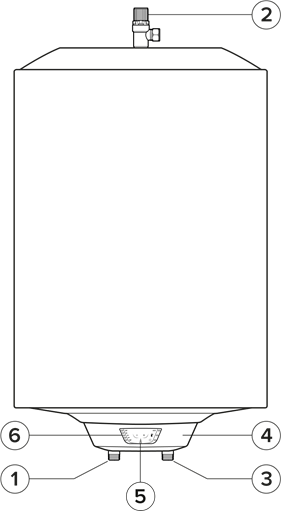
- Hot water outlet (1/2 male BSP)
- Temperature and pressure relief valve
- Cold water inlet (1/2 male BSP)
- Control cover
- Regulation Keyboard
- Heating Led
TECHNICAL CHARACTERISTICS
For the technical specifications, refer to the nameplate (the nameplate is located next to the water intake/outlet pipes).
Table 1 — Product information
| Product range | 50 | 80 | 100 |
| Weight when empty (kg) | 17 | 22 | 26 |
| Weight when full (kg) | 66 | 97 | 121 |
| Installation | Vertical | Vertical | Vertical |
| Model | Refer to the nameplate | ||
| SMART | X | X | X |
| Qelec (kWh) | 6,855 | 7,115 | 7,439 |
| Qelec, week, smart (kWh) | 24,928 | 25,699 | 25,765 |
| Qelec, week (kWh) | 28,997 | 31,110 | 32,868 |
| Load profile | M | M | M |
| L wa (dB) | 15 | ||
 wh wh |
39,8% | 39,8% | 40,0% |
| V40 (L) | 65 | 92 | 130 |
| Heat loss (kWh/day) | 0,917 | 1,253 | 1,434 |
| Heat up times [15-60°C] (minutes) | 60 | 97 | 128 |
| Maximum inlet pressure [rated pressure] (bar) | 12 | ||
| Maximum design pressure (bar) | 6 | ||
| Set operating pressure expansion valve (bar) | 6 | ||
| Pre-charge pressure of the expansion vessel (bar) | 3,5 | ||
| Set opening T&P relief valve (bar) | 7 | ||
| Capacity (l) | 49 | 75 | 95 |
The power consumption data in the table and the other information given in the Product Data Sheet (Enclosure A to this manual) are defined in relation to EU Directives 812/2013 and 814/2013.
The products without the label and the data sheet for water heaters and solar devices, stipulated in regulation 812/2013, are not intended to be used in such assemblies.
The device is equipped with a smart function that allows you to adapt the consumption to the user profiles. If operated correctly, the device has a daily consumption of «Qelec* (Qelec, week, smart/Qelec, week)» less than that of an equivalent product with no smart function».
This appliance is conforming with the international electrical safety standards IEC 60335-1 and IEC 60335-2-21. The CE marking of the appliances attests its conformity to the following EC Directives, of which it satisfies the essential requisites:
- LVD Low Voltage Directive: EN 60335-1, EN 60335-2-21, EN 60529, EN 62233, EN 50106.
- EMC Electro-Magnetic Compatibility: EN 55014-1, EN 55014-2, EN 61000-3-2, EN 61000-3-3.
- RoHS2 Risk of Hazardous Substances: EN 50581.
- ErP Energy related Products: EN 50440.
- EN 12897:2016
This product is in conformity with REACH regulations.
Water Regulations and Byelaws
These regulations and byelaws ensure a good supply of wholesome water, and that only approved materials, pipes and fittings are used to convey water.
Building Regulations
These are a statutory document and take priority over all other regulations and recommendations. The installation of an unvented hot water system of over 15 litres is classified as a «Controlled Service» and Regulation G3 applies. To meet the requirements of the regulation, installation of an unvented system should be undertaken by a «competent installer».
All installations of unvented hot water storage systems having a capacity of more than 15 litres should be notified to the relevant Local Authority by means of building notice or by the submission of full plans. It is important to note that it is a criminal offence to install an unvented hot water storage system over 15 litres without notifying the Local Authority.
Delivery
The products are supplied with the following:
Unvented water heater (with factory-fitted T&P) x1
Pressure relief valve set at 6 bar x1
Dielectric junctions x2
Tundish x1
Expansion Vessel x1
Check Valve x1
Pressure reducing Valve x1
Dielectric junctions must be fitted to all models as they prevent an electrolytic reaction and safeguard against potential aggressive corrosion.
If the supplied Dieletric Junctions are not fitted this could void the warranty.
INSTALLATION NORMS (for the installer)
Before installing the heater read these instructions in full. If you are unsure please contact our technical service department (03332407777).
The installation must comply with all relevant Water Regulations/Byelaws and Building Regulations.
The installer should check with the local water authority for confirmation of the maximum water supply pressure.
The appliance should be left packed until it is ready to be installed. When unpacking take care not to damage the temperature and pressure relief valve on the top of the heater.
A drain has to be provided for any water discharged through the safety valves.
A cold water supply pressure between 1 and 3.5 bar is required (if the mains pressure is above 3.5 bar a pressure reducing valve must be installed). Please note that turning down the stop-cock will reduce flow not pressure.
The outlet pressure from the reducing valve (if supplied) is 3.5 bar.
A 240 VAC; 3 kW single phase electrical supply is required.
This product is a device that must be installed vertically in order to operate correctly. Once installation is complete, and before any water is added or the power supply is connected, use a measuring instrument (i.e. a spirit level) to check that the device has been installed perfectly vertical. The appliance heats water to a temperature below boiling point. It must be linked up to a mains water supply according to the appliance performance levels and capacity. Before connecting the appliance, it is first necessary to:
- Check whether the characteristics (please refer to the data plate) meet the customer’s requirements.
- Make sure the installation conforms to the IP degree (of protection against the penetration of liquids) of the appliance according to the applicable norms in force.
- Read the instructions provided on the packaging label and on the appliance data plate.
This appliance was designed to be installed only inside buildings in compliance with the applicable norms in force. Furthermore, installers are requested to keep to the following advice in the presence of:
- Damp: do not install the appliance in closed (unventilated) and damp rooms.
- Frost: do not install the appliance in areas where the temperature may drop critically and there may be a risk that ice may form.
- Sunlight: do not expose the appliance to direct sunrays, even in the presence of windows.
- Dust/vapours/gas: do not install the appliance in the presence of particularly dangerous substances such as acidic vapours, dust or those saturated with gas.
- Electrical discharges: do not install the appliance directly on electrical supplies that aren’t protected against sudden voltage jumps.
In the case of walls made of bricks or perforated blocks, partition walls featuring limited static, or masonry different in some way from those stated, you first need to carry out a preliminary static check of the supporting system.
The wall-mounting fastening hooks must be designed to support a weight that is three times higher than the weight of the water heater filled with water.
Fastening hooks with a diameter of at least 12 mm are recommended.
To facilitate maintenance, make sure there is a clearance of at least 50 cm inside the enclosure for access to the electrical equipment.
PLUMBING WARNING
Note: If a valve i.e. a non return valve, water meter, pressure reducing valve or any type of valve or fitting that acts as a non return valve is installed on the cold water mains, this will prevent expansion. Therefore it will be necessary to install an expansion vessel (see figure below).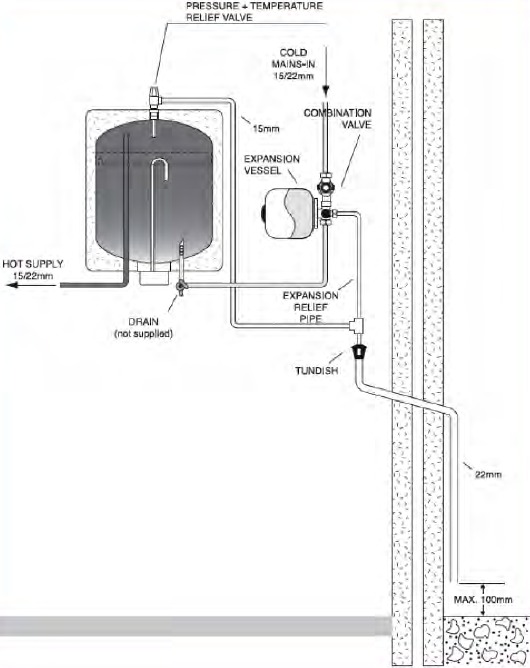
Note: If in doubt always install a pressure reducing valve (limited to 3.5bar) and expansion vessel.
The outlet from temperature and pressure relief valve/pressure relief valve must not be for any other purpose. Take great care not to allow any swarf into the pipe work or fittings, as this might impair the operation of the safety valve(s).
The water connection may be carried out as per the following:
Do not fit any stop cocks or isolating valves within the distance required for expansion. If a pressure reducing valve is needed, due to a mains pressure of over 3.5 bar, an expansion control kit must be fitted regardless of expansion pipework installed. The expansion distances quoted are for 15mm pipes and can be approximately halved for 22mm pipes.
The appliance must not be supplied with water of hardness less than 12°F, not with especially hard water (greater than 25°F); we recommend installing a water softener, properly calibrated and controlled — do not allow the residual hardness to fall below 15°F.
The appliance is covered under the Building Regulations and therefore it is not possible to accommodate the expansion water within the system pipe work and consequently a set of expansion controls must be installed.
Note: The discharge from relief valves must be made in a safe and conspicuous manner.
Please note that in all cases the dielectric junctions must be connected to the heater before any other connection is made (these prevent an electrolytic reaction).
If the supplied Dieletric Junctions are not fitted this could void the warranty.
Only the use of copper pipe is recommended for connection to the heater. If any other material is used it must be able to withstand 90°C at 7 bar pressure for long periods.
No valve must be fitted between the expansion/pressure relief valve and the water heater.
All other required safety components to install the appliance are supplied as a kit with the appliance: 15mm pressure reducing valve set at 3.5bar. Expansion vessel (charge pressure set at 3.5bar)»
DISCHARGE PIPE WORK NOTE
The following guidelines refer to Building Regulation G3. It is good practice to follow these guidelines for all relief valve discharge pipe work.
- The tundish must be vertical and fitted within 600 mm of the temperature & pressure relief valve and must be located with the cylinder. The tundish must also be in a position visible to the occupants, and positioned away from any electrical devices. The discharge pipe from the tundish should terminate in a safe place where there is no risk to persons in the vicinity of the discharge and to be of metal.
- Discharge pipes from the temperature & pressure relief and pressure relief valve may be joined together.
- The pipe diameter must be at least one pipe size larger than the nominal outlet size of the safety device unless its total equivalent hydraulic resistance exceeds that of a straight pipe 9 m long.
i.e. Discharge pipes between 9 m and 18 m equivalent resistance length should be at least 2 sizes larger than the nominal outlet size of the safety device. Between 18 m and 27 m at least 3 times larger, and so on. Bends must be taken into account in calculating the flow resistance. See fig.1 and Table 2. - The discharge pipe must have a vertical section of pipe at least 300 mm in length, below the tundish before any elbows or bends in the pipe work.
- The discharge pipe must be installed with a continuous fall.
- The discharge must be visible at both the tundish and the final point of discharge, but where this is not possible or practically difficult; there should be clear visibility at one or other of these locations. Examples of acceptance are:
- Ideally below a fixed grating and above the water seal in a trapped gully.
- Downward discharges at a low level; i.e. up to 100 mm above external surfaces such as car parks, hard standings, grassed areas etc. These are acceptable providing that where children may play or otherwise come into contact with discharges, a wire cage or similar guard is positioned to prevent contact, whilst maintaining visibility.
- Discharges at high level; i.e. into a metal hopper and metal down pipe with the end of the discharge pipe clearly visible (tundish visible or not). Or onto a roof capable of withstanding high temperature discharges of water 3 m from any plastic guttering systems that would collect such a discharge (tundish visible).
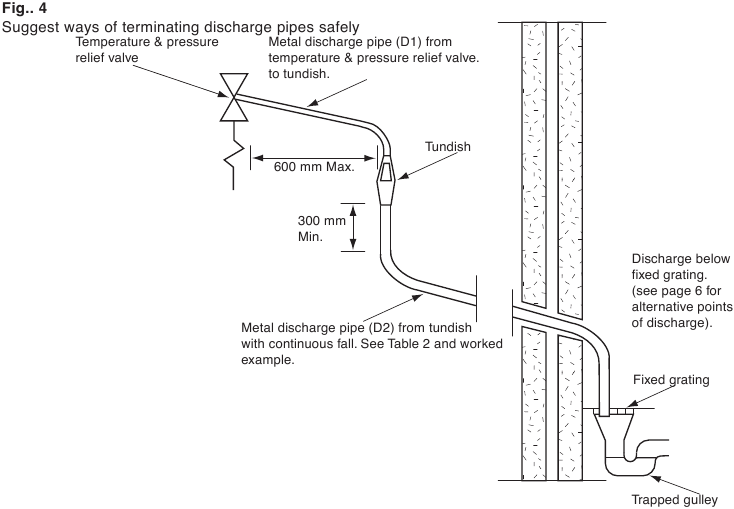
- Where a single pipe serves a number of discharges, such as in blocks of flats, the number served should be limited to no more than 6 systems so that any installation can be traced reasonably easily. The single common discharge pipe should be at least one pipe size large than the largest individual discharge pipe to be connected. If unvented hot water storage systems are installed where discharges from safety devices may not be apparent i.e. in dwellings occupied by the blind, infirm or disabled people, consideration should be given to the installation of an electronically operated device to warn when discharge takes place. Note: The discharge will consist of scalding water and steam. Asphalt, roofing felt and non-metallic rainwater goods may be damaged by such discharges.
Table 2
Sizing of copper discharge pipe «D2» for common temperature valve outlets.
| Valve outlet size | Minimum size of discharge pipe D1* | Minimum size of discharge pipe D2* from tundish | Maximum resistance allowed, expressed as a length of pipe (i.e. no elbow or bends) | Resistance created by each elbow or bend |
| G 1/2 | 15 mm |
22 mm 28 mm 35 mm |
Up to 9 m Up to 18 m Up to 27 m |
0.8 m 1.0 m 1.4 m |
| G 3/4 | 22 mm |
28 mm 35 mm 42 mm |
Up to 9 m Up to 18 m Up to 27 m |
1.0 m 1.4 m 1.7 m |
| G 1 | 28 mm |
35 mm 42 mm 54 mm |
Up to 9 m Up to 18 m Up to 27 m |
1.4 m 1.7 m 2.3 m |
Worked example
The example below is for a G 1/2″ temperature & pressure relief valve with a discharge pipe (D2) having 4 no. elbows and length of 7 m from the tundish to the point of discharge.
From Table 2
Maximum resistance allowed for a straight length of 22 mm copper discharge pipe (D2) from G 1/2″ T & P valve is 9 m. Subtract the resistance for 4 no. 22 mm elbows at 0.8 m each = 3.2 m. Therefore the maximum permitted length equates to: 5.8 m.
As 5.8 m is less than the actual length of 7 m therefore calculate the next largest size.
Maximum resistance allowed for a straight length of 28 mm pipe (D2) from G 1/2″ T & P valve equates to: 18 m. Subtract the resistance for 4 no. 28 mm elbow at 1.0 m each = 4 m. Therefore the maximum permitted length equates to: 14 m
As the actual length is 7 m, a 28 mm (D2) copper pipe will be satisfactory.
Draining the appliance
The appliance must be drained if left inactive in a room subject to frost and/or in the event of prolonged inactivity.
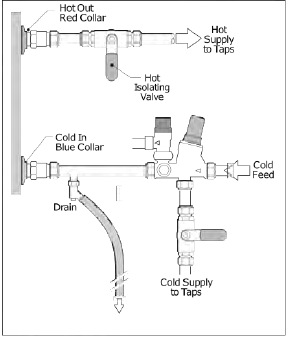
Typical drain arrangement and system designs will vary:
- Turn power off to ensure appliance is not operated when empty.
- Turn off cold supply to appliance.
- Shut off hot water feed from appliance.
- Connect hose to drain cock and place other end in sink, basin etc.
- Open drain cock and open TPR valve to vent cylinder.
ELECTRICAL WARNING
The appliance must be earthed
The electrical installation must be in line with the current I.E.E. wiring regulations. A mains supply of 240 VAC 3 kW (13 amps) is required (Fig. 2)
Heat resisting cable, round 3 core 1.5 mm (to BS 6141 table  should be used to connect to the electrical supply through either:
should be used to connect to the electrical supply through either:
- a 13 amp socket to BS 1363; or
- a double pole fused isolating switch with a contact separation of 3 mm minimum on each pole.
Flexible cables are colour coded as follows:
Brown — live
Blue — neutral
Green and yellow — earth
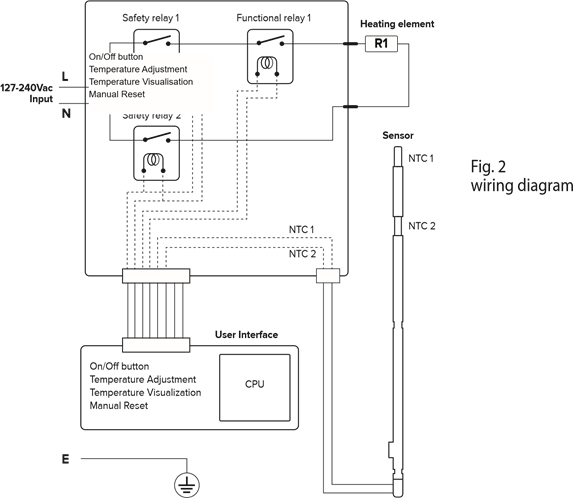
To enter into the terminal compartment unscrew the 2 screws on the cover.
(To access the screws, remove the decorative caps on the front control access panel).
It is mandatory, before installing the appliance, to perform an accurate control of the electrical system by verifying compliance with current safety standards, which is adequate for the maximum power absorbed by the water heater (refer to the data plate) and that the section of the cables for the electrical connection is suitable and complies with local regulations. The manufacturer is not liable for damage caused by lack of grounding or anomalous power supply. Before starting up the appliance, check that the power rating matches that given on the nameplate.
The use of multiplugs, extensions or adaptors is strictly prohibited.
It is strictly forbidden to use the piping from the plumbing, heating and gas systems for the appliance earthing connection. If the appliance is supplied with a power supply cable, should the latter need replacing, use a cable featuring the same characteristics. The power cord must be routed into the hole in the back of the appliance and connected to the thermostat terminals (M Fig. 4).
The appliance must be grounded with a cable (yellow/green and longer than the phase cable) connected to the terminals marked ![]() (G Fig. 4).
(G Fig. 4).
COMMISSIONING
- Check that all the necessary components are supplied and for those not factory fitted, that they are the type recommended by the manufacturer for the particular water heater.
- Check that the water heater/components are undamaged.
- Check that the discharge pipe is plumbed so that it falls continuously and that no taps, valves or other shut-off devices are installed in the pipe.
- Check that the discharge pipe drains safely to waste and is readily visible.
- Check, in the case where some components are not factory fitted, that they are marked so as to refer to the warning label on the water heater.
- Open all outlet taps.
- Turn on the mains water supply.
- Close taps in turn as water flow stabilises with no air bubbles.
- Check for leaks.
- Check that no water is passing through the safety valve(s).
- Test the operation of the safety valve(s) by lifting/turning the lever/knob, and observing that water flows through and safely to waste.
- Switch on electricity and set thermostat to at 60°C to reduce the build up of scale in hard water areas.
- Check the water heats up.
- Check that <<warning to user label>> is secure and visible on the heater and related warning labels are fitted to the controls.
- Demonstrate operation to user, including operation of safety valve(s) and what to do if it/they operate(s).
- Give this handbook to the user and discuss future maintenance.
- Drain and refill the entire system ensuring it is flushed in accordance with BS6700.
MAINTENANCE REGULATIONS (for qualified personnel)
Before calling your Technical Servicing Centre, check that the fault is not due to lack of water or power failure.
disconnect the appliance from the mains before conducting any maintenance work.
Replacing parts (Fig. 4)
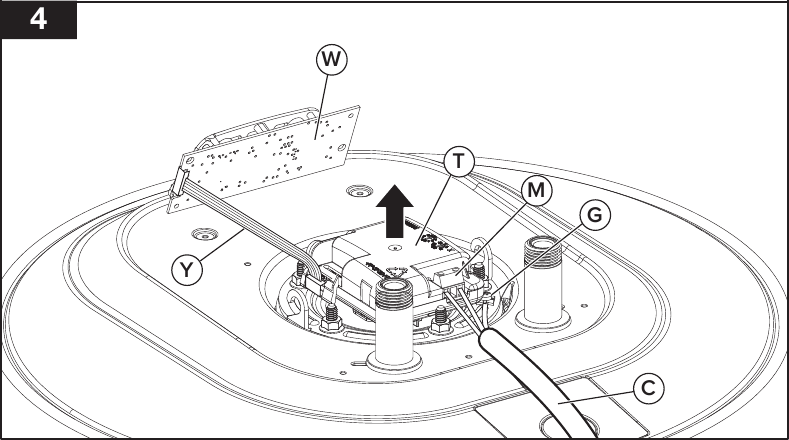
Remove the enclosure to access the electrical equipment.
To work on the electronic thermostat (Ref. T), disconnect the power supply cable (Ref. C) and the control panel wire (Ref. Y). Next, remove it from its slot, taking care not to bend the sensor support rod too much.
To work on the control panel (Ref. W), disconnect the wire (Ref. Y) and loosen the screws.
During reassembly, make sure that all components are put back in their original positions.
In order to work on the heating element and the anode, the appliance must first be emptied.
Undo the 5 bolts (C fig. 5) and remove the flange (F fig. 5). The heating element and anode are attached to the flange. During reassembly, make sure that the flange gasket, the thermostat and the heating element are put back in their original positions (Fig. 5).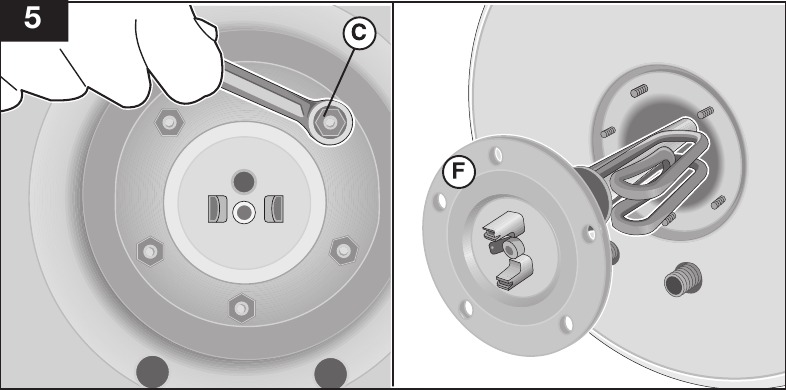
We recommend replacing the flange gasket (Z Fig. 6) every time it is disassembled.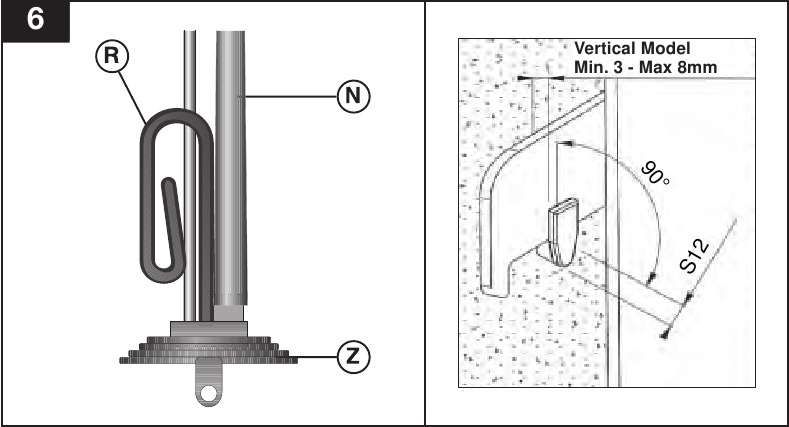
Use only original parts from authorised service centres authorised by the manufacturer.
Periodical maintenance
The heating element (R fig. 6) should be descaled every two years (the frequency must be increased, if water is very hard) to ensure it works properly. If you do not wish to use a liquid descaler (in this case please read the safety data sheets of descaling), you can simply break off the deposit, taking care not to damage the heating element’s cladding. The magnesium anode (N fig. 6) must be replaced every two years, otherwise the decay of the warranty. In the presence of aggressive or waters rich in chloride it is recommended to check the status of the anode annually.
To remove this, disassemble the heating element and unscrew from the support bracket.
Check controls (where fitted) as per the following:
- Line strainer — with the water supply turned off remove screen from strainer and clean of any detritus;
- Expansion vessel — with the water supply turned off and taps open, check expansion vessel pressure and top up as necessary;
- Temperature & pressure relief valve — with the water supply turned on, check manually by lifting the test lever/turning the test knob (ensure valve closes after testing);
- Expansion relief valve — check manually by turning the test knob (ensure valve closes after testing);
- Discharge pipes (D1) — from both temperature & pressure relief and expansion relief valve for obstructions;
- Tundish & discharge pipe (D2)- open either valve gradually to produce a full bore discharge into tundish and D2 without any back pressure;
- Pressure reducing valve — check that the correct outlet pressure is being maintained by recording the pressure at an in-line terminal fitting i.e. tap.
USER INSTRUCTIONS
Reset/Diagnostics
When one of the malfunctions described above occurs, the appliance will enter its «fault status» and all LEDs on the control panel will flash simultaneously.
Reset: to reset the appliance, switch the product off and on again using the ![]() button (Ref. A). If the cause of the malfunction disappears immediately following the reset process, the appliance will resume normal operation. If this is not the case, all the LEDs will continue to flash; contact the Technical Assistance Centre.
button (Ref. A). If the cause of the malfunction disappears immediately following the reset process, the appliance will resume normal operation. If this is not the case, all the LEDs will continue to flash; contact the Technical Assistance Centre.
Diagnostics: to enable the diagnostic function, hold the ![]() button (Ref. A) for 5 seconds. The type of fault is indicated by five LEDs (Ref. 1 >5) according to the following scheme:
button (Ref. A) for 5 seconds. The type of fault is indicated by five LEDs (Ref. 1 >5) according to the following scheme:
LED Ref. 1 – Internal P.C.B. malfunction;
LED Ref. 2 – Anode malfunction (in models fitted with active anode);
LED Ref. 3 – NTC 1/NTC 2 temperature sensors broken (open or short-circuited);
LED Ref. 5 – Water overheating detected by an individual sensor;
LEDs Ref. 4 and 5 – General overheating (P.C.B. malfunction);
LEDs Ref. 3, 4 and 5 – Operation without water.
Exit the diagnostic function by pressing the ![]() button (Ref. A) or wait for 25 seconds.
button (Ref. A) or wait for 25 seconds.
«Thermal disinfection cycle» function (anti-legionella)
The anti-legionella function is activated by default. It consists of a heating/maintenance cycle of the water at 60°C for 1h so as to carry out thermal disinfection action against the relevant bacteria.
The cycle starts at the first ignition of the product and after each re-ignition which follows a lack of mains power. If the product always work at a temperature below 55°C, the cycle is repeated after 30 days. When the product is off, the anti- legionella function is not active. If the appliance is switched off during the anti-legionella cycle, the product turns off and the function is not completed. At the end of each cycle, the operating temperature returns to the value set previously by the user. The activation of the «anti-legionella cycle» is displayed as a normal temperature setting at 60°C. (Led Ref. 4). To permanently disable the anti-legionella function simultaneously hold down the «ECO» and «+» buttons for 3 sec.; confirming deactivation the led 40° will C flash rapidly for 4 sec. To reactivate the anti-legionella function, repeat the operation described above; to confirm the reactivation of the led (Ref. 4) will flash rapidly for 4 sec.
Adjusting the temperature and activating the functions (Fig. 3)
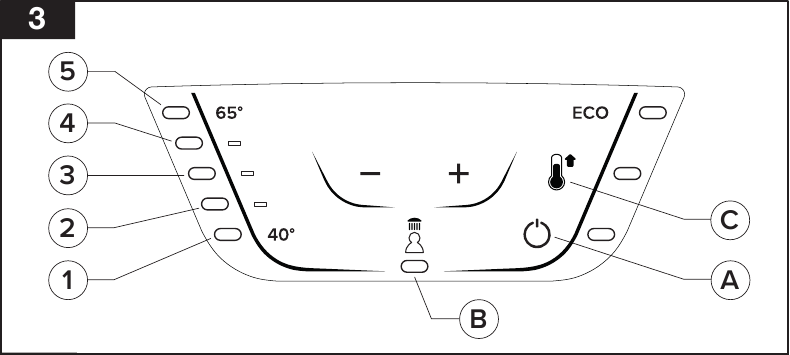
Press the button (Ref. A) to switch on the appliance. Set the desired temperature by using the «+» and «-» buttons to select a level between 40°C and 65°C. During the heating phase, the LEDs (Ref. 1> 5) corresponding to the temperature reached by the water so far remain lit in a fixed manner; all subsequent LEDs (up to the set temperature) flash progressively. If the temperature drops, for example after hot water has been used, the heating is reactivated automatically and the LEDs between the last fixed light and the light corresponding to the set temperature will resume flashing progressively. The first time the product is switched on, it will be set to a temperature of 60°C (Led Ref. 4).
In the event of a power failure or if the product is switched off using the button (Ref. A), the most recently set temperature remains memorised. During the heating phase, a slight noise may be produced as a result of the water heating process.
The LED remains ON during heating.
ECO FUNCTION
The Eco function is activated/deactivated by pressing the corresponding button. If the function is activated the led will be switched on. The Eco function aims to produce hot water by learning the user habits. So, for the first week ever the product memorises the tappings and the periods in which those tappings take place. From the following weeks the water heating is performed regarding what was learned previously. If the user wants to reset the function and start a new learning period, it is necessary to press the ECO button for 3 seconds (the eco led will appear blinking). If during Eco function, PLUS or MINUS button are pressed the function will be deactivated.
SHOWER READY
The Shower Ready LED (B, Fig. 3) indicates whether there is hot water for at least one shower. The quantity of hot water is determined by internal parameters and varies according to the model.
MAX FUNCTION
The Max function (C, Fig. 3) is activated/deactivated by pressing the corresponding button. If the function is active, the LED will be lit. The Max function temporarily sets the set-point temperature to 65°C by bypassing the previous operating mode (if the Eco function is active, the self-learning function is temporarily interrupted and deactivates on its own once the set-point is reached).
The Max function is deactivated even if there is a stall error, if the «OFF» status is engaged or if the +/– buttons are pressed to change the set-point.
Setting the set-point
By pressing the PLUS or MINUS buttons, the user can choose the set-point temperature (indicated by the temperature LEDs, with the other LEDs off ). Each press of the button increases or decreases the set temperature by 10 degrees. After 5 seconds without any action, the set-point will be confirmed and memorised.
STALL STATUS
There are two possible stall statuses:
- TOUCH CONTROL STALL STATUS
If a touch control error is detected, the status of the touch LED is undetermined and cannot be controlled. This status is indicated by the flashing of the temperature LEDs (fast if the product is on, slow if it is off ). - OTHER STALL STATUS
If other errors are detected, all the LEDs will start flashing.
To reset a non-volatile error, if possible, it is necessary to press the ON/OFF button (Fig. 3) to switch the product on and off. To verify which error occurred, it is necessary to enter the diagnostics state by simultaneously pressing the ON_OFF and MAX BUTTONS for 3 seconds. After 25 seconds, the system will return to the stall status. Note: for the Chinese market (set through NFC), the product is reset by simultaneously pressing the ON/OFF and ECO buttons for 5 seconds.
USEFUL INFORMATION (for the user)
Before any operation of cleaning the device make sure to turn off the product by bringing the external switch to the OFF position. Do not use insecticides, solvents or aggressive detergents that may damage the painted parts or plastic material.
If the water delivery is cold, have the following checked:
- that the device is connected to the power supply and the external switch is in the ON position.
- that at least led 40°C (1 fig. 3) is turned on.
If there is presence of steam output from the taps:
Remove power from the electrical appliance and contact technical support.
If the hot water delivery is insufficient, have the following checked:
- the pressure of the water mains;
- eventual obstruction of the inlet and outlet pipes (deformation or sediment).
IF THE PROBLEM PERSISTS, NEVER ATTEMPT TO REPAIR THE APPLIANCE YOURSELF — ALWAYS HAVE THIS DONE BY A QUALIFIED TECHNICIAN.
The indicated data and specifications are not binding; the manufacturer reserves the right to modify them at his own discretion notification or replacement.
This product conforms to Directive WEEE 2012/19/EU.

The symbol of the crossed waste paper basket on the appliance and its packaging indicates that the product must be scrapped separately from other waste at the end of its service life. The user must therefore hand the equipment over to a sorted waste disposal facility for electro-technical and electronic equipment at the end of its service life.
Alternatively, he may return the equipment to the retailer at the time of purchase of a new equivalent type of appliance. Electronic equipment of size less than 25 cm can be handed over to any electronics equipment retailer whose sales area is at least 400 m2 for disposal free of charge and without any obligation to purchase new product.
Installation scheme
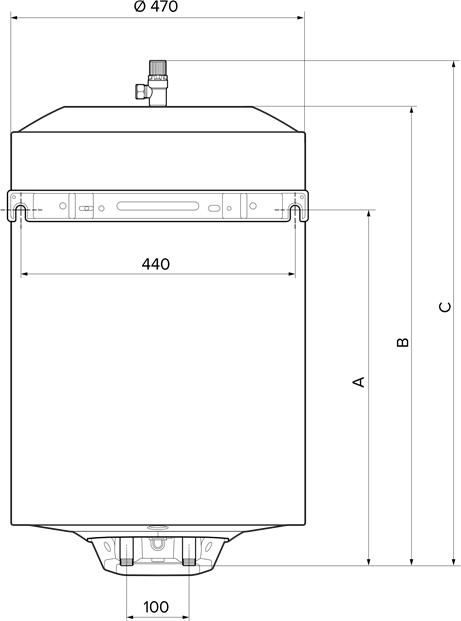
| Model | A | B | C |
| 50V | 365 | 531 | 605 |
| 80V | 570 | 736 | 810 |
| 100V | 722 | 888 | 962 |
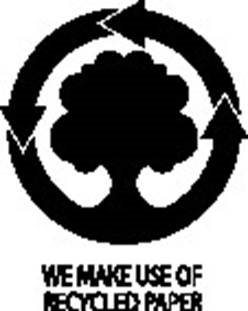
Ariston Thermo S.p. A.
Viale Aristide Merloni, 45
60044 Fabriano (AN)
Tel. (+39) 0732.6011
ariston.com

Here you can download full pdf version of manual, it may contain additional safety instructions, warranty information, FCC rules, etc.
Электрические накопительные водонагреватели Ariston серии ABS BLU R SLIM
Электрические накопительные водонагреватели Ariston серии ABS PRO SMALL.
Электрические накопительные водонагреватели Ariston серии ABS PRO ECO
Электрические накопительные водонагреватели Ariston серии ABS PRO ECO
Электрические накопительные водонагреватели Ariston серии ABS PRO ECO
Электрические накопительные водонагреватели Ariston серии ABS PRO ECO INOX
Электрические накопительные водонагреватели Ariston серии ABS PRO ECO INOX PW 30 V SLIM
Электрические накопительные водонагреватели Ariston серии ABS PRO ECO INOX SLIM 30-50-80-100.
Электрические накопительные водонагреватели Ariston серии ABS PRO ECO SLIM 30-50-65-80.
Электрические накопительные водонагреватели Ariston серии ABS PRO PLUS POWER 50-80-100.
Электрические накопительные водонагреватели Ariston серии ABS PRO PLUS POWER SLIM 30-50-65-80.
Электрические накопительные водонагреватели Ariston серии ABS PRO R SLIM 30-50-65-80
Электрические накопительные водонагреватели Ariston серии ABS BLU ECO SLIM
Электрические накопительные водонагреватели Ariston серии SGHP 50 V.
Электрические накопительные водонагреватели Ariston серии SB R
Электрические накопительные водонагреватели Ariston серии ELITE
Электрические накопительные водонагреватели Ariston серии ELITE
Электрические накопительные водонагреватели Ariston серии ELITE
Электрические накопительные водонагреватели Ariston серии ABS VLS EVO WIFI PW
Электрические накопительные водонагреватели Ariston серии LYDOS ECO ABS PW
Электрические накопительные водонагреватели Ariston серии LYDOS R ABS
Электрические накопительные водонагреватели Ariston серии ABS ANDRIS LUX 6 OR
Электрические накопительные водонагреватели Ariston серии ABS ANDRIS LUX 6 UR
Электрические накопительные водонагреватели Ariston серии ABS VLS EVO PW, ABS VLS EVO INOX PW, ABS VLS EVO QH, ABS VLS EVO INOX QH
Электрические накопительные водонагреватели Ariston серии ABS ANDRIS R
Электрические накопительные водонагреватели Ariston серии ABS ANDRIS R U
Электрические накопительные водонагреватели Ariston серии DUNE1 R
Электрические накопительные водонагреватели Ariston серии DUNE1 R INOX
Электрические накопительные водонагреватели Ariston серии DUNE1 R INOX SLIM
Электрические накопительные водонагреватели Ariston серии JOVIS
Электрические накопительные водонагреватели Ariston серии LEXIS
Электрические настенные накопительные водонагреватели Ti-Tronic BEST
Электрические настенные накопительные водонагреватели Ti-Tronic BEST 30 V, Ti-Tronic BEST 50 V, Ti-Tronic BEST 65 V, Ti-Tronic BEST 80 V, Ti-Tronic BEST 100 V, Ti-Tronic BEST 120 V, Ti-Tronic BEST 150 V, Ti-Tronic BEST 30 H, Ti-Tronic BEST 50 H, Ti-Tronic BEST 65 H, Ti-Tronic BEST 80 H, Ti-Tronic BEST 100 H, Ti-Tronic BEST 120 H, Ti-Tronic BEST 150 H, Ti-Tronic BEST 80 T, Ti-Tronic BEST, Ti-Tronic BEST 100 T. Инструкция по монтажу и техническому обслуживанию.
